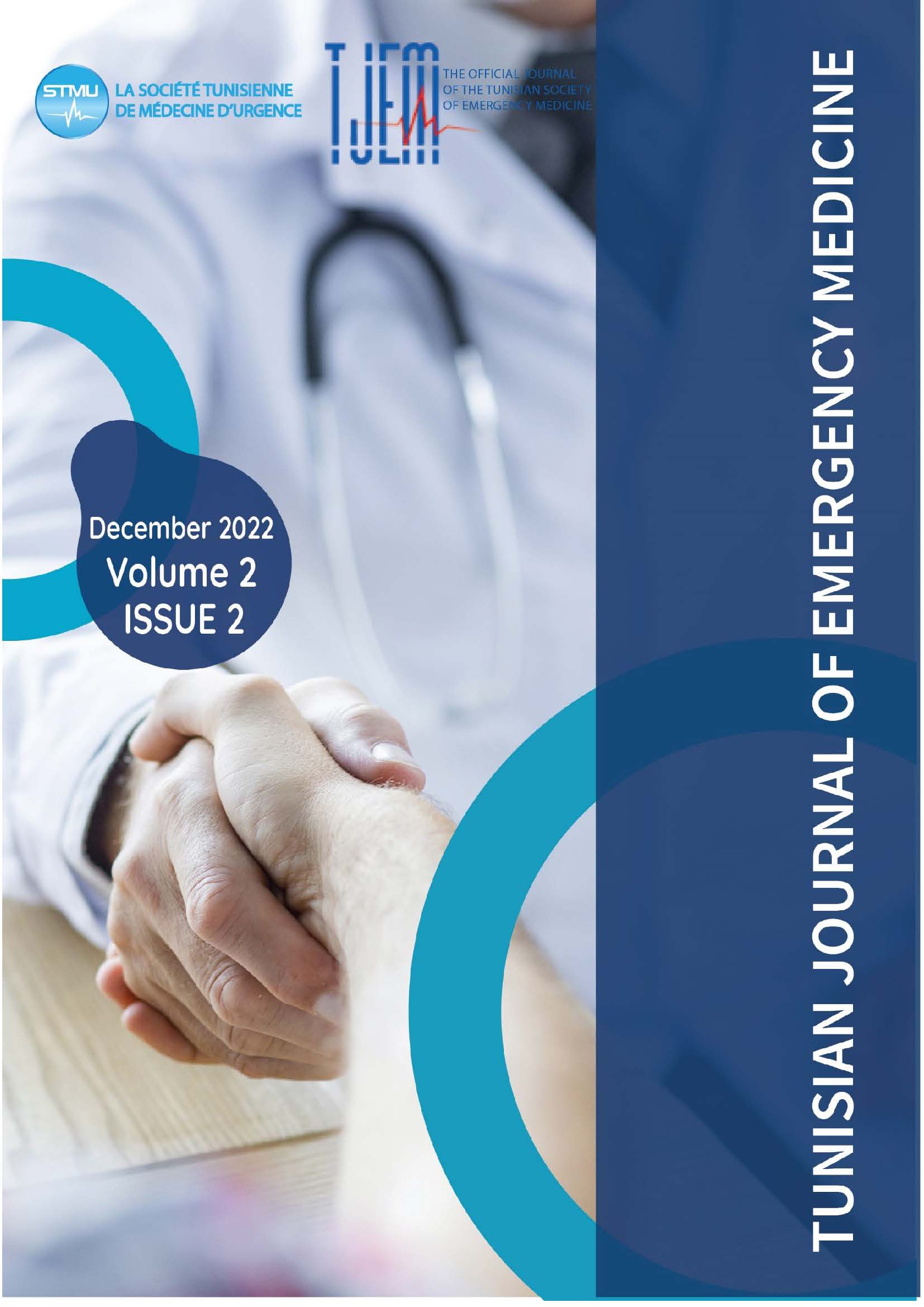Prognostic factors of assault-induced stab wounds in the emergency department
Safia OTHMANI, Sarra JOUINI, Asma MELLOULI, Houyem ZOUARI, Mouna JEMAI, Hana HEDHLI
DOI:
https://doi.org/10.0000/qabsd008Keywords:
Trauma, Stab wounds, Blood pressure, Respiratory rate, prognosisAbstract
Background: Stab wounds (SWs) represent one of the major components of trauma, especially in the emergency department (ED), and can have dreadful outcomes.
Aim: Our study aimed to assess the different epidemiological, clinical, and therapeutic features of SWs in the ED as well as prognostic factors determining short-term evolution (STE).
Method: A descriptive, cross-sectional single-center study was conducted in a polyvalent ED room of the Charles Nicolle hospital of Tunis, including patients presenting for assault-induced over ten months.
Unfavorable STE was defined by: oxygen therapy needs, fluid expansion, catecholamine and/or tranexamic acid use, transfusion, thoracic drainage, intubation, and urgent surgery.
The statistical analysis concerned the study population (SP) subgroups who have penetrating stab wounds (PSWs) or superficial stab wounds (SSWs). The risk factors search of STE was carried out by a univariate analysis, binary logistic regression with Receiver Operating Characteristics curves (ROC) analysis.
Results: We included 130 patients, with male predominance and a sex ratio of 15. The median age was 30. The majority (90.8%) had no pathological medical history. Forty percent of the injuries were located on the torso (n=52). Initial clinical assessment showed that most of the patients were hemodynamically stable Four patients (3.1%) had systolic blood pr tients (6.2%) a mean arterial blood pressure (MAP) <65mmHg. Seven patients (5.4%) were hypoxemic. Univariate analysis showed that respiratory rate (RR), and blood pressure (BP) were significantly associated with unfavorable STE. Receiving operating curve (ROC) analysis concluded a high discriminating ability for RR and BP. Logistic regression analysis showed that RR>19cpm and SBP <105 mmHg are independent risk factors with respective AORs of 8.64 and 14.29 IC.
Conclusion: Unfavorable STE can be predicted through clinical parameters such as RR>19cpm and/or SBP<105 mmHg in PSW's victims.
Downloads
Published
Issue
Section
License
Copyright (c) 2022 Tunisian Journal of Emergency Medicine

This work is licensed under a Creative Commons Attribution-NonCommercial-ShareAlike 4.0 International License.
How to Cite
Similar Articles
- Asma ZORGATI, Short and long-term outcomes of patients presenting with Acute Coronary Syndrome without ST-segment elevation (NSTE -ACS): findings from a Tunisian Register: the ReSCUS Register , Tunisian Journal of Emergency Medicine: Vol. 2 No. 2 (2022): TJEM Vol2 Issue2
- Ikhlass BEN AICHA, Importance of Simulation in setting up ultrasoundguided vascular access , Tunisian Journal of Emergency Medicine: Vol. 2 No. 2 (2022): TJEM Vol2 Issue2
- olfa DJEBBI, Can we predict the clinical scenario of acute heart failure based only on NT proBNP rate without using echocardiography? , Tunisian Journal of Emergency Medicine: Vol. 2 No. 3 (2023): TJEM Vol2 Issue3
- Houda BEN SOLTANE, Predicting diabetic ketoacidosis severity score: proposal of a therapeutic strategy adapted to emergency department , Tunisian Journal of Emergency Medicine: Vol. 2 No. 3 (2023): TJEM Vol2 Issue3
- Insaf MISSAOUI, A measles outbreak in Tunisia: Experience of an Emergency Department in Sousse , Tunisian Journal of Emergency Medicine: Vol. 2 No. 3 (2023): TJEM Vol2 Issue3
- Wiem Ben AMAR, Evaluation of initial medical certificates delivered by emergency doctors , Tunisian Journal of Emergency Medicine: Vol. 2 No. 3 (2023): TJEM Vol2 Issue3
- Souayah Ahmed, Acute aortic syndromes in emergency departments , Tunisian Journal of Emergency Medicine: Vol. 2 No. 2 (2022): TJEM Vol2 Issue2
- Houda BEN SOLTANE, Evaluation of the prescription of additional examinations in emergency departments , Tunisian Journal of Emergency Medicine: Vol. 2 No. 2 (2022): TJEM Vol2 Issue2
- Cyrine KOURAICHI, Value of inferior vena cava diameter respiratory change as a marker of heart failure in COPD exacerbation , Tunisian Journal of Emergency Medicine: Vol. 2 No. 2 (2022): TJEM Vol2 Issue2
- Houda BEN SOLTANE, Predicting diabetic ketoacidosis severity score: proposal of a therapeutic strategy adapted to the emergency department , Tunisian Journal of Emergency Medicine: Vol. 2 No. 2 (2022): TJEM Vol2 Issue2
You may also start an advanced similarity search for this article.
Most read articles by the same author(s)
- safia othmani, Ischemic acute cholecystitis: a case report , Tunisian Journal of Emergency Medicine: Vol. 2 No. 4 (2024): TJEM Vol2 Issue4

